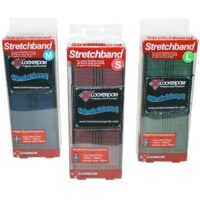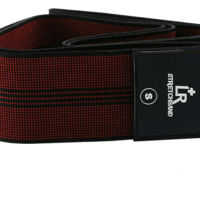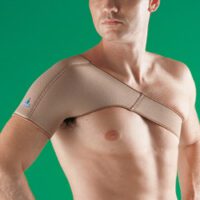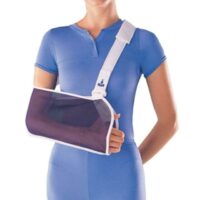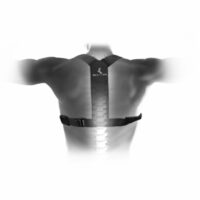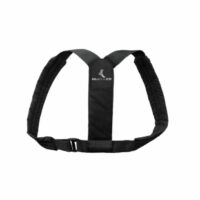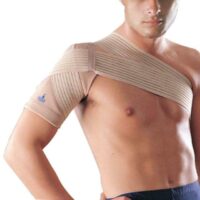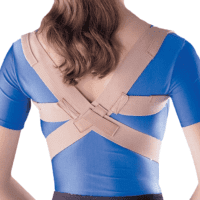Scapular Muscles
Article by John Miller

Scapular Muscles
What is Scapular Stabilisation?
Introduction
Scapular stabilisation is crucial for shoulder health and function. The scapular muscles play a key role in maintaining the stability and movement of the shoulder joint. This article aims to enlighten you about the importance of these scapular muscles, how to strengthen them, and the role of physiotherapy in maintaining shoulder health.
What are your Scapular Muscles?
The scapula, commonly known as the shoulder blade, serves as an attachment point for several muscles, which play crucial roles in the movement and stability of the shoulder. These muscles include:
- Trapezius: This large muscle extends from the neck and upper spine to the shoulder. It has three parts (upper, middle, and lower) that help in moving the scapula and supporting the arm.
- Levator Scapulae: As its name suggests, this muscle elevates the scapula. It originates in the cervical spine and attaches to the upper part of the scapula.
- Rhomboids (Major and Minor): Located between the spine and the scapula, these muscles retract the scapula, pulling it towards the spine.
- Serratus Anterior: This muscle fans out from the upper ribs to the underside of the scapula. It plays a key role in protracting and stabilising the scapula.
- Deltoid: This muscle caps the shoulder and is attached to the lateral aspect of the scapula. It is crucial for arm abduction.
- Supraspinatus: Part of the rotator cuff, it arises from the supraspinous fossa of the scapula and helps in lifting the arm.
- Infraspinatus: Another rotator cuff muscle, it originates in the infraspinous fossa of the scapula and aids in rotating the arm laterally.
- Teres Minor: Also part of the rotator cuff, this muscle extends from the lateral border of the scapula to the humerus and assists in rotating the arm.
- Teres Major: While not a part of the rotator cuff, it is located near the teres minor and helps in internal rotation and adduction of the arm.
- Subscapularis: This is the largest of the rotator cuff muscles, covering the anterior surface of the scapula and playing a role in rotating the arm medially.
- Pectoralis Minor: This muscle attaches to the coracoid process of the scapula and helps in stabilising the scapula.
- Omohyoid (Inferior Belly): Part of this muscle attaches to the superior border of the scapula, although it primarily functions in neck movements.
- Latissimus Dorsi: While most of this large muscle is attached to the spine and pelvis, a part of it extends to the scapula, playing a role in internal rotation, adduction, and extension of the shoulder.
These muscles work in coordination to facilitate a wide range of shoulder movements and contribute to the overall stability and function of the shoulder joint.
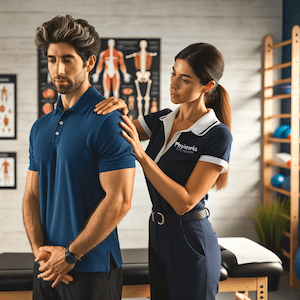
The Role of Scapular Muscles
The scapula, or shoulder blade, works in tandem with the rotator cuff muscles to stabilise your shoulder joint during movement. The rotator cuff muscles originate from the scapula and attach to the humerus (upper arm bone). Without a stable scapula, you risk conditions like rotator cuff tendinopathy or impingement.
Recent research highlights the increasing prevalence of shoulder impingement, especially among athletes and individuals engaged in repetitive upper body activities, underscoring the importance of scapular muscle health.
Strengthening Your Scapular Muscles
To maintain optimal shoulder stability and prevent injuries, it’s essential to focus on strengthening specific scapular muscles. The trapezius, with its upper, middle, and lower fibres, and the serratus anterior are particularly important. These muscles, often weakened due to lifestyle factors or improper training, play a crucial role in shoulder mechanics.
Importance of Targeted Exercises
Scapular stabilisation exercises are specifically designed to target these muscle groups. These exercises not only enhance shoulder function but also significantly reduce the risk of common shoulder problems.
Addressing Other Scapular Muscles
While the rhomboids and levator scapulae are also critical scapular muscles, the trapezius and serratus anterior are more prone to weakness and injury. Therefore, our emphasis is on strengthening these muscles, which are pivotal in maintaining scapular stability.
A Holistic Approach
Incorporating exercises that engage the entire scapular region, including the rhomboids and levator scapulae, provides a comprehensive approach to shoulder health. This holistic strategy ensures all supporting muscles work synergistically, offering better protection against injury and enhancing overall shoulder function.
Enhancing Scapular Posture Correction
Beyond Military Posture: Comprehensive Scapular Alignment
While adopting a ‘military posture’—shoulders back, chest out—is fundamental for correct scapular positioning, it’s just the beginning. This posture aids in reducing the risk of shoulder impingement, bursitis, and rotator cuff tears. To further enhance scapular stability, engage your mid and lower trapezius muscles. These muscles are key for retracting the shoulder and pulling the scapula downwards, actions that are critical in preventing rotator cuff issues.
The Dynamic Range of Scapular Motion
It’s important to recognise that the scapula has a broad range of motion, requiring control throughout its entire operational span. For instance, during arm elevation, the scapula contributes approximately 60 degrees of the total 180-degree movement necessary for full elevation. Therefore, focusing solely on strengthening in a ‘military posture’ overlooks the crucial aspect of controlling the scapula in functional zones above shoulder height. Weakness in this zone would place you at injury risk when lifting overhead and throwing for example.
Addressing Full Range Scapular Control
To achieve comprehensive scapular control, exercises should encompass movements that extend beyond the basic posture. This includes exercises that involve elevation, rotation, and protraction of the scapula. By training the scapula to operate effectively throughout its entire range, you can ensure better shoulder mechanics and further reduce the risk of injury.
The Importance of Balanced Scapular Training
Balanced scapular training is key. It involves not only strengthening the stabilising muscles but also ensuring flexibility and control across the scapula’s full range of motion. Such a balanced approach leads to a well-aligned scapula, crucial for optimal shoulder function and health.
The Importance of Scapulo-Humeral Rhythm
Your physiotherapist plays a vital role in assessing and correcting your scapulo-humeral rhythm, a key component of shoulder function. Poor scapulo-humeral rhythm is a major cause of rotator cuff impingement. Physiotherapists can guide you through exercises tailored to your specific needs, contributing significantly to rehabilitation success.
Can a Posture Brace Help?
In some cases, a posture brace can be beneficial for scapular posture training below 90-degrees shoulder elevation. It provides passive support, helping to maintain correct shoulder and scapular alignment. However, it’s essential to consult with a physiotherapist to determine if a brace is suitable for your condition.
Conclusion
Scapular stabilisation is a cornerstone of shoulder health. Understanding and working on the strength and stability of the scapular muscles can significantly improve shoulder function and prevent common injuries. Incorporating appropriate exercises into your routine, under the guidance of a physiotherapist, is key to achieving and maintaining optimal shoulder health.
What to Do? Seeking Professional Advice
If you’re experiencing shoulder pain or discomfort, or if you’re keen on improving your shoulder stability and function, consulting a shoulder physiotherapist is a wise decision. They can provide tailored advice and exercise regimes suited to your specific needs. Remember, proactive measures and professional guidance are your best allies in maintaining shoulder health.
For more information and resources on scapular stabilisation and shoulder health, visit PhysioWorks, a comprehensive source for physiotherapy insights and advice.





